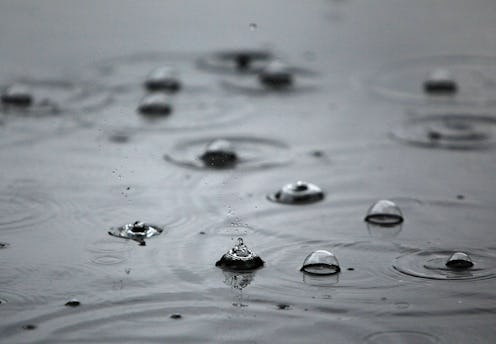News
Science Figured Out Why Rain Smells So Good
Ever breathed in deeply after a rainfall because the air smelled so good? That distinct rain smell that you associate with summer and your childhood and everything that's good and right in the world? Well, scientists have now discovered what exactly causes this magical rain scent. Researchers at MIT filmed a slow-motion video of raindrops, which reveals that when the rain hits the ground it releases aerosols that carry aromatic elements. It's the first time scientists have studied this smell-inducing mechanism, and the results could lead to a better understanding of certain diseases.
Though there is a scientific name for the scent of rain — petrichor: a smell that frequently accompanies the first rain after a long period of warm, dry weather — scientists didn't know what exactly caused that smell until now. Using high-speed cameras that captured raindrops at the point of impact, the MIT researchers observed that raindrops trap tiny air bubbles when it hits a porous surface, releasing aerosols that bring out the scent of the surface (such as soil), which creates that distinct rain aroma.
Cullen R. Buie, an assistant professor of mechanical engineering at MIT, and his team found that the aerosols released by rain could help to explain how certain soil-based diseases spread. Youngsoo Joung, a postdoc in Buie's lab, wrote in the study:
Until now, people didn’t know that aerosols could be generated from raindrops on soil. This finding should be a good reference for future work, illuminating microbes and chemicals existing inside soil and other natural materials, and how they can be delivered in the environment, and possibly to humans.
So how do these aerosols work and what exactly do they look like?
"Frenzied Aerosols"
Buie and Joung described the phenomenon as "frenzied aerosols" in their study, which was published in the journal Nature Communications. Basically, it means that as a raindrop makes impact with a surface, it flattens, and at the same time tiny bubbles rise up through the drop and burst into the air. Those bubbles then create a cloud of "frenzied aerosols."
Joung explains:
Frenzied means you can generate hundreds of aerosol droplets in a short time — a few microseconds. And we found you can control the speed of aerosol generation with different porous media and impact conditions.
Moderate Rains Make Stronger Smells
The scientists observed that the amount of aerosols released, and therefore how strong the smell is, depends on the velocity of the raindrop (how hard it hits the ground) and the permeability of the surface (how porous it is). Using 28 different surface types — 12 engineered materials and 16 soil samples — the team discovered that rain that falls at a moderate speed onto surfaces that aren't too wet or dry produce the most amount of aerosols. In other words, light or moderate rain that falls on clay or sandy soils would make the most aerosols.
Joung added:
Heavy rain [has a high] impact speed, which means there’s not enough time to make bubbles inside the droplet.
Rain Looks Like Champagne
So what exactly does this aerosol phenomenon look like? The study compares the rain's released aerosols to the fizz in a glass of champagne as a helpful analogy for visualizing the phenomenon. In the video, the tiny particles that burst from the raindrops do look exactly like the top of a champagne glass right after it's poured.
How It Can Help Curb Disease
From their observations, the researchers suspect that in addition to the aromatic elements of soil, the aerosols might also bring out bacteria and viruses stored in the ground. This sheds light on how aerosols might be helping to spread soil-based diseases in the air.
James Bird, an assistant professor of mechanical engineering at Boston University, wrote:
Microbes from soil have been observed high in the atmosphere; this paper provides an elegant mechanism by which these microbes can be propelled past the stagnant layer of air around them to a place where the breeze can take them elsewhere.
Joung and another graduate student, Zhifei Ge, are now studying to see if soil contaminants such as E. coli can be spread by rainfall.
Watch the study's video below.
Images: Massachussetts Institute of Technology/YouTube (2), Getty Images (2)
